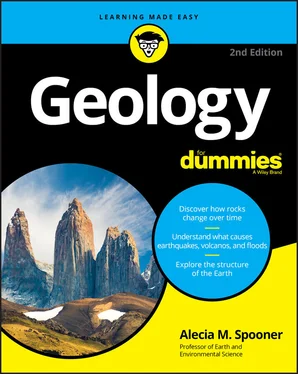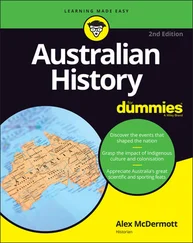Sedimentary: Most sedimentary rocks form by the cementation of sediment particles that have settled to the bottom of a body of water, such as an ocean or lake. (There are also some sedimentary rocks, which are not formed this way. I describe these in Chapter 7as well.)
Metamorphic: Metamorphic rocks are the result of a sedimentary, igneous, or other metamorphic rock being squeezed under intense amounts of pressure or subjected to high amounts of heat (but not enough to melt it) that change its mineral composition.
Each rock exhibits characteristics that result from the specific process and environmental conditions (such as temperature, or water depth) of its formation. In this way, each rock provides clues to events that happened in Earth’s past. Understanding the past helps us to understand the present and, perhaps, the future.
Tumbling through the rock cycle
The sequence of events that change a rock from one kind into another are organized into the rock cycle. It is a cycle because there is no real beginning or end. All the different types of rocks and the various earth processes that occur are included in the rock cycle. This cycle explains how materials are moved around and recycled into different forms on the earth’s surface (and just below it). When you have a firm grasp on the rock cycle, you understand that every rock on Earth’s surface is just in a different phase of transformation, and the same materials may one day be a very different rock!
Mapping Continental Movements
Most of the rock-forming processes of the rock cycle depend on forces of movement, heat, or burial. For example, building mountains requires force exerted in two directions, pushing rocks upward or folding them together. This type of movement is a result of continental plate movements. The idea that the surface of the earth is separated into different puzzle-like pieces that move around is a relatively new concept in earth sciences, called plate tectonics theory (the subject of Part 3).
Unifying geology with plate tectonics theory
For many decades, earth scientists studied different parts of the earth without knowing how all the features and processes they examined were tied together. The idea of plate movements came up early in the study of geology, but it took a while for all the persuasive evidence to be collected, as I describe in Chapter 8.
By the middle of the twentieth century, scientists had discovered the Mid-Atlantic Ridge and gathered information about the age of sea floor rocks across the ridge. With this evidence they proposed the theory of plate tectonics suggesting the earth’s crust is broken into pieces, or plates. Where two plates touch and interact is called a plate boundary .
Exactly how the earth’s crustal plates interact is determined by the type of motion and type of crustal material. These interactions are described as plate boundary types and include:
Convergent boundaries: At convergent boundaries, two crustal plates are moving toward one another and come together. Depending on the density of the crustal plates, this collision builds mountains, or causes plate subduction (meaning one plate goes beneath another), producing volcanoes.
Divergent boundaries: At divergent plate boundaries, two crustal plates are separating or moving apart from one another. These boundaries are most commonly observed along the sea floor, where the upwelling of magma along the boundary creates a mid-ocean ridge, but they may also occur on continents, such as in the African rift valley.
Transform boundaries: At transform boundaries, the two plates are neither colliding nor separating; they are simply sliding alongside one another.
In Chapter 9, I provide the details on the different characteristics of continental plates and how they interact as they move around Earth’s surface, including the particular geologic features associated with each plate boundary type.
Debating a mechanism for plate movements
While the unifying theory of plate tectonics has been well-accepted by the scientific community, geologists have yet to agree on what, exactly, drives the movement of continental plates.
Three dominant forces are thought to work together to drive plate tectonic motion:
Mantle convection: The convection of the mantle — the movement of heated rock materials beneath Earth’s crust is thought to be the dominant driver of plate motion. Mantle rock moves outward towards the crust when it is heated, and then cools and sinks back towards the core (sort of like the wax in a lava lamp). As it moves, the crustal plates resting on the outer mantle are carried along.
Ridge-push: The ridge-push force is a result of new crustal rock forming at a mid-ocean ridge. The addition of new crust at the plate edge will push the plate away from the ridge and towards the plate boundary along its outer or opposite edge.
Slab-pull: As the ridge is pushing the plate away, the outer edge of such a plate will be sinking into the mantle, and as this slab sinks, it pulls the plate along behind it — creating the slab-pull force.
Mantle convection, ridge-push, and slab-pull forces work together to drive plate tectonic motion. In Chapter 10, you will find more details on how these three forces are constantly reshaping the surface of the earth.
Moving Rocks around on Earth’s Surface
On a smaller than global scale, rocks are constantly being moved around on Earth’s surface. Surface processes in geology include changes due to gravity, water, ice, wind, and waves. These forces sculpt Earth’s surface, creating landforms and landscapes in ways that are much easier to observe than the more expansive processes of rock formation and tectonic movement. Surface processes are also the geologic processes humans are more likely to encounter in their daily lives.
Gravity: Living on Earth you may take gravity for granted, but it is a powerful force for moving rocks and sediment. Landslides, for example, result when gravity wins over friction and pulls materials downward. The result of gravity’s pull is mass wasting, which I explain in Chapter 11.
Water: The most common surface processes include the movement of rocks and sediment by flowing water in river and stream channels. The water makes its way across Earth’s surface, removing and depositing sediment, reshaping the landscape as it does. The different ways flowing water shapes the land are described in Chapter 12.
Ice: Similar to flowing water but much more powerful, ice moves rocks and can shape the landscape of an entire continent through glacier erosion and deposition. The slow-flowing movement of ice and its effect on the landscape are described in Chapter 13.
Wind: The force of wind is most common in dry regions, and you are probably familiar with the landforms it creates, called dunes. You may not realize that the speed and direction of wind create many different types of dunes, which I describe in Chapter 14.
Waves: Along the coast, water in the form of waves is responsible for shaping shorelines and creating (or destroying) beaches. In Chapter 15, I describe in detail the various coastal landforms created as waves remove or leave behind sediments.
Interpreting a Long History of Life on Earth
One of the advantages of studying geology is being able to learn what mysteries of the past are hidden in the rocks. Sedimentary rocks, formed layer by layer over long periods of time, tell the story of Earth’s living history: changing climates and environments, as well as the evolution of life from single cells to modern complexity.
Using relative versus absolute dating
Читать дальше












